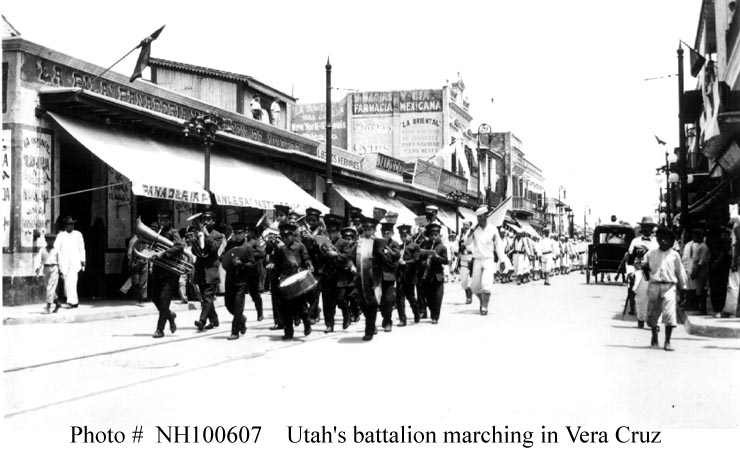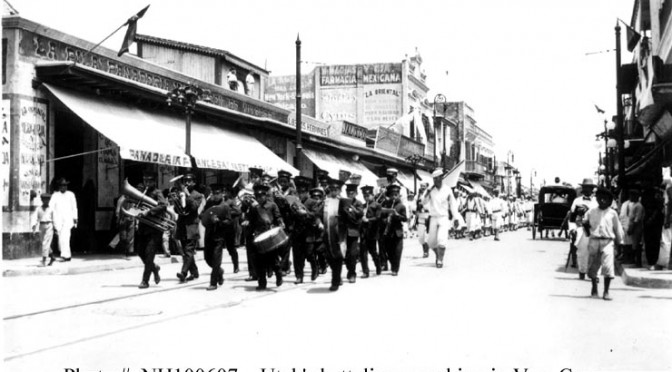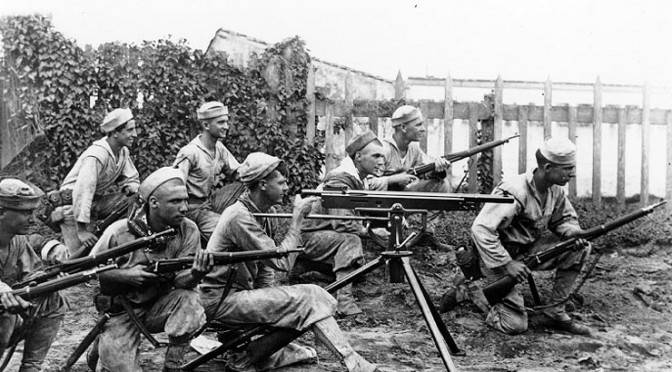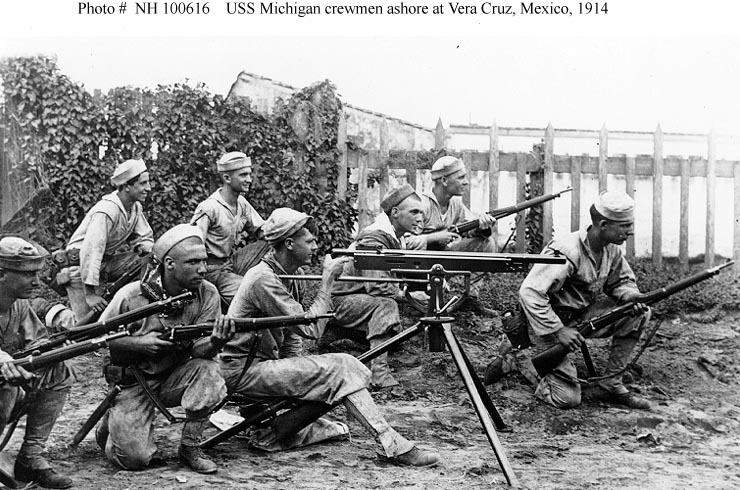
This is the second installment in a three part series on the American occupation of Veracuz in 1914. The first article can be found here.
On the morning of 21 April 1914, Rear Admiral Frank F. Fletcher, commander of the U.S. Navy task force offshore Veracruz, Mexico, complied with the order he had received from from Secretary of the Navy Josephus Daniels the night before. Fletcher ordered the landing of 1200 Marines and sailors from his ships to seize the customs house in Veracruz in order to prevent the delivery of the weapons onboard the German freighter Ypiranga to the Mexican Army, even before he was reinforced by ships commanded by his counterpart off Tampico, Rear Admiral Henry T. Mayo, and the Atlantic Fleet’s steaming from Norfolk. According to John Eisenhower’s Intervention! The United States and the Mexican Revolution, the Americans anticipated resistance from the Veracruz garrison of 600 soldiers, and 2000-3000 other Mexican troops in the region that could be augmented by militia and freed prisoners. Fletcher hoped that moving ashore quickly would preempt a defense by local troops, enable a potential occupation, and allow him to avoid using his ships’ big guns to obliterate the city.
According to another account of the Veracruz operation, Jack Sweetman’s the Landing at Veracruz: 1914, the “Naval Brigade,” commanded by Captain William Rees Rush, the commanding officer of USS Florida, was composed of two regiments: the First Marine Regiment (22 officers and 578 men assembled from Marines onboard Fletcher’s ships) and the First Seaman Regiment (30 officers and 570 sailors from Florida and USS Utah). They went ashore from their ships anchored in the harbor onboard whaleboats towed by motor launches to Pier Four in the port.
As soon the landings started, the American consul in Veracruz telephoned General Gustavo Maass, the local Mexican commander, encouraging him not to fight back and allow the Sailors and Marines to come ashore unopposed. Maass, in a rage, instead immediately informed 100 men from a regiment billeted nearby to engage the Americans. After a conversation with the Minister of Defense, Maass was forced to reverse himself, however, as the Minister instructed him to withdraw his troops ten miles inland to the town of Tejería. The Mexican Army’s involvement in the fight thus almost immediately ended, with the bulk of resistance over the next few days conducted by Veracruz’s civilian residents, who had some military training and organization as a militia (the “Society of Defenders of the Port of Veracruz”) as part of a program Huerta had implemented the previous year.
That same morning, Ypiranga was sighted steaming towards the harbor and was interdicted by crew from USS Utah. The master cooperated and provided shipping documents to the boarding team, which ironically showed that the weapons on the ship had not originated in Hamburg, but were Remingtons made in the U.S. that had been routed through Europe to evade Wilson’s embargo on arms exports to Huerta’s army.
With the Mexican Army out of the fight, one of the main sources of resistance left was from the Naval Academy, where cadets fired at the at the Americans landing at Pier Four. They emulated the example of the niños heroiques, cadets at the Mexican military academy in Mexico City in 1847 who threw themselves to their deaths from the cliffs of Chapultepec to save the flag and avoid surrender to a previous generation of American invaders. The cadets defending the Naval Academy in 1914 soon joined the ranks of the honored dead after fire from the guns of Fletcher’s ships silenced their resistance (enabled by Chief Boatswain John McCloy, who drove the motor launch he commanded towards the Academy, fired against it to draw a response, thus allowing the location of the defending cadets to be spotted and engaged by the ships’ guns, an act earning McCloy his second Medal of Honor).
That afternoon Admiral Fletcher cabled Washington with his first report of the landing stating that
“Mexican forces…opened fire with rifle and artillery after our seizure of the Custom House…Ypiranga arrived Veracruz two PM anchored in outer harbor and [was] notified he would not be allowed to leave port with munitions of war aboard. Holding Custom House and section of city in vicinity of wharves and Consulate. Casualties two PM four dead twenty wounded.”
The following day on 22 April, additional forces flowed into Veracruz with the arrival of ships and Marines from both Tampico and the Norfolk-based Atlantic Fleet, with the additional Sailors and Marines augmenting the Brigade ashore and expanding the American occupation throughout the whole city by engaging in fierce house-to-house fighting. The famous Marine hero Smedley Butler, then a Major, described a urban battle scene not particularly different from those in which Marines would fight throughout the next century:
“The sailors who traveled openly through the streets were badly shot up, not only by Mexicans but in at least one instance by their own men, but the Marine casualties were slight. Two of my men were killed and four or five wounded. We Marines decided on different tactics than the sailors. Stationing a machine gunner at one end of the street as a lookout, we advanced under cover, cutting our way through the adobe walls from one house to another with axes and picks. We drove everybody from the houses and then climbed up on the flat roofs to wipe out the snipers.”
Meanwhile, in Washington, Secretary of State William Jennings Bryan apologized to the German government for the unlawful detention of Ypiranga. Bryan, like President Woodrow Wilson and Navy Secretary Daniels was well known as a devout Christian with a pacifist reputation and opposition to the military adventurism of the previous Republican administrations in Latin America and the Philippines, but was ironically overseeing the violent invasion of one of the U.S.’s closest neighbors on remarkably flimsy grounds.
By 23 April Admiral Fletcher had transferred his command ashore with most of the resistance having melted away, but, according to Sweetman’s account, was unable to convince any of the local authorities to restore some form of government, as a law passed in the wake of the 1862 French invasion of Mexico made holding “office under a foreign power occupying Mexican soil” a criminal offense. The official casualty figures by 24 April listed 126 Mexicans killed and 195 wounded (an amount probably significantly lower than the actual total, since these numbers were based only on wounded and dead recorded by local hospitals), with 17 killed and 63 wounded Americans.
Although the Naval Brigade had been reinforced and occupied virtually all of Veracruz, Admiral Fletcher was concerned that the Mexican Army was massing up to 16,000 troops in the vicinity of the city, dwarfing the number of Marines and Sailors ashore, many of whom were also needed back on ship in case of future operations at sea. Therefore the U.S. Army’s Fifth Reinforced Brigade, commanded by Brigadier General Frederick Funston, was dispatched from the U.S. on 24 April, arriving a few days later. After negotiating the status of the Marines, the Army troops went ashore and took responsibility for the city from the naval units in a ceremony on 30 April (the debate over who “owned” the Marines foreshadowed future arguments over task organization in a joint force. Ultimately the Marines that were attached to Navy ships returned to their afloat commands, while the rest of the force “chopped” to Army control). Despite significant support for a broader war with Mexico in the press and segments of Congress, Funston led an uneventful, combat-free, occupation of Veracruz for another seven months as the machinations associated with a diplomatic solution to the crisis were worked out.
Stay tuned for the third and final installment of this series, which discusses the aftermath of the occupation.
Lieutenant Commander Mark Munson is a Naval Intelligence officer currently serving on the OPNAV staff. He has previously served at Naval Special Warfare Group FOUR, the Office of Naval Intelligence, and onboard USS Essex (LHD 2). The views expressed are solely those of the author and do not reflect the official viewpoints or policies of the Department of Defense or the US Government.





